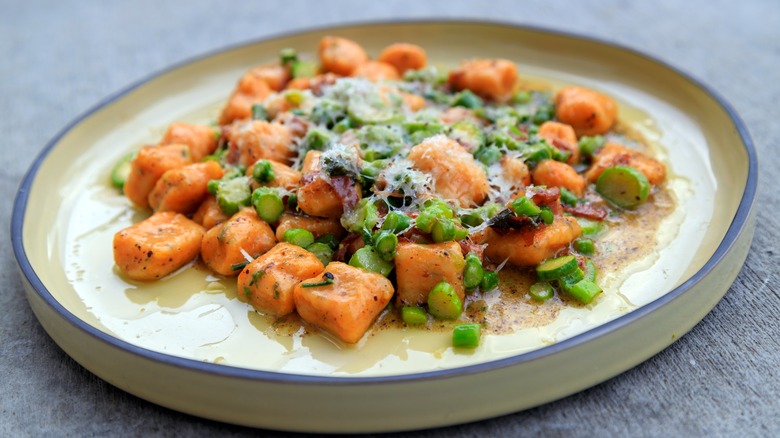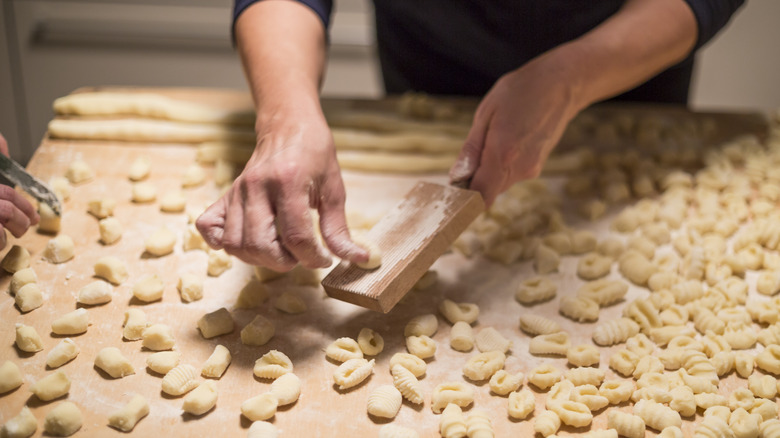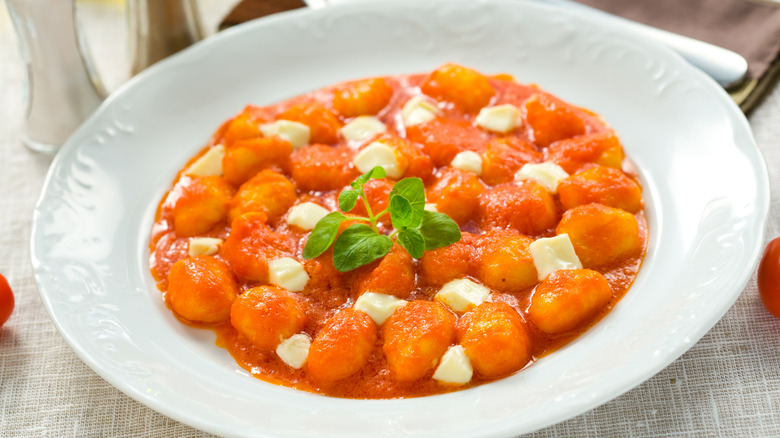2-Ingredient Gnocchi Is Too Easy Not To Try
Created in Northern Italy, gnocchi is the commonly mispronounced pasta ('n(y)oh-kee'), often referred to as a dumpling. Traditionally made with a base of white potatoes, gnocchi's simplicity has inspired cooks to experiment with variations containing cheese and other vegetables while dressing the pillowy pasta in everything from pesto to boar ragu.
While the ingredient list is simple, perfecting this pasta-making technique can take some practice, and it can appear to be intimidating initially. But, with only two ingredients (plus salt), it's nearly effortless to make a dish like sweet potato gnocchi — in fact, it's too easy not to try.
Containing just baked sweet potatoes and all-purpose flour, these fluffy dumplings are more forgiving to make than their starchier white potato cousins, meaning there's less chance they will end up rubbery or gummy. Since the sweet potatoes are baked, not boiled, like in other recipes, there are also fewer steps and no need to dry out the spuds before making the dough.
Although a potato masher and fork are the only tools you really need to make the dish, the results are more reliable when using a potato ricer or food mill. Since a ricer also helps make the creamiest mashed potatoes, it's a gadget worth making space for in the kitchen.
Tips when making gnocchi
As mentioned, a potato ricer or food mill is the best tool for mashing the potatoes needed for gnocchi since the flesh will be squeezed into grain-size pieces, leaving the potato fluffy and not overworked. The spuds should also be lump-free and warm before adding the required flour.
The amount of flour needed depends on how large the potatoes are and the humidity in your kitchen. Expect roughly ½ cup to 1 cup of flour per potato. Gnocchi can also be made with gluten-free flour if you prefer, without altering the recipe.
Like any recipe containing flour, the more you work the dough, the tougher it will be. Since you'll want delicate, fluffy gnocchi, a light hand is needed. In addition, starchy potatoes tend to get gummy when over-whipped, so knead long enough to pull the ingredients together but still keep the dough soft.
When forming the gnocchi, roll the dough into ½-inch thick ropes, then cut the gnocchi the width of your finger. Although this step is unnecessary, you can also make the pasta look professional and pick up more sauce by rolling each gnocchi along the tines of a fork to make the characteristic ridges. Next, place the gnocchi on a parchment-lined sheet pan as you work the rest of the dough, preventing them from touching.
Gnocchi can be frozen at this stage and stored in a resealable freezer bag for up to a month. When ready to cook, boil the gnocchi directly from the freezer, adding a few minutes to the cooking time.
White versus sweet potato gnocchi
In terms of taste, as the name suggests, sweet potato gnocchi are a sweeter pasta than those made with white potatoes, which is an important factor when deciding what sauce to serve them with. Since traditional gnocchi are more bland, they can be dressed with any type of sauce, just like you would with dried semolina pasta. In contrast, sweet potato gnocchi (and other flavored options like beet gnocchi and pumpkin gnocchi) are best served with minimal sauces like brown butter and sage or a light cream sauce with grated Parmesan, so the pasta's flavor isn't obscured.
Despite a common misconception about the often-maligned white potato, both gnocchi options can be a nutritious part of your diet. While both potatoes contain similar calories, protein content, carbohydrates, and high concentrations of fiber and vitamins B6 and C, they differ in taste, appearance, and benefits.
White potatoes also contain more potassium than sweet potatoes, which are high in vitamin A. Although how you prepare the potatoes is a factor, sweet potatoes are generally lower on the glycemic index, so if your blood sugar is a concern, sweet potato gnocchi may be a better option (via Healthline). If you don't care for sweet potatoes, this two-ingredient gnocchi can also be made with the standard Idaho potato.



